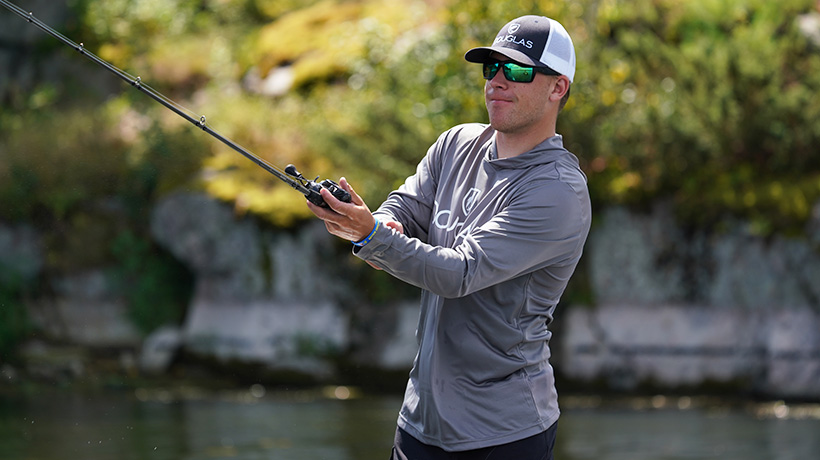A Carolina Rig is a plastic bait rig most commonly used to target bass – knowing when and where to fish it is important to success.
It is a perfect technique to use when fish are feeling lethargic and are sitting down deep – hugging tight to the bottom or suspended a few feet off of it. Utilizing a Carolina Rig will help you get down to the fish with an enticing presentation they want to see.

Fishing Carolina Rig
First off – what is a Carolina rig? A Carolina rig is typically setup up with larger, soft plastic baits with weight fixed above the hook and is often presented in a slower, more tantalizing way.
The idea is to slowly drag the weight along the bottom, getting a feel for every rock bed, ledge, shoal or grass flat you’re fishing with your bait slowly trailing behind. After a long and slow drag, reel up your slack and give your rod a pop or two, before dragging it again. Longer casts come in handy as they allow you to place your bait beyond the fish you’re targeting to make a subtle, finesse entrance in their zone.
Texas Rig vs Carolina Rig
A Carolina Rig is similar to a Texas Rig, but the main difference in Texas Rig vs Carolina Rig is how the weights are set up and the presentation that is used. Carolina Rigs are a better option for fishing deeper, more open-water. Whereas a Texas Rig is more suited flipping your bait around structure.
When to Use a Carolina Rig
When trying to decide when use a Carolina Rig there are a few things to consider, such as:
- Weather
- Water temperature
- Water depth
- Time of year
When the weather gets hot and the sun beats down, it raises the surface temperature. Fish will often head deeper to find cooler water. By the time the fish find cooler water, they are often exhausted and less active – a slow moving, easy meal is just what they need.
There are a variety of factors that may cause fish to sit deeper, but the most common is seeking cooler water during the hot summer months. Fishing a Carolina Rig often means being on the water when the sun is fierce and the temperature is high.
Be sure to protect your skin from the sun while fishing. Our hooded fishing shirts will keep you cool and safe from the sun!
Another key component is utilizing your electronics. A Carolina Rig a perfect option for when the bite is slow and bass are just not hitting moving baits. Using your graphs to find fish will put you in the right spot so you can concentrate slowing down your presentation – not on covering a bunch of water.
When bass are down in deeper water, they will often group up on the bottom of a ledge, brush pile, or any other structure they can find. Using your graphs is crucial for finding fish around structure.
Carolina Rig Setup
Before you can start throwing a Carolina Rig, you have to know how to set one up first. Here is everything you need to have for a Carolina Rig setup.
- A heavy bullet weight – typically between 1/2 oz to 1 1/2 oz, bobber stopped or not.
- A plastic bead.
- A swivel.
- A leader line – 1’ to 3’ of 12-15lbs of mono is recommended.
- A wide gap hook anywhere from 3/0 to a 5/0 depending on the size of your soft plastic bait.
- Main line – this can be a personal preference. Most prefer braid for castability and strength while others would argue a heavy 17-20lb even 25lb Fluorocarbon for better hooksets.
- Soft plastic baits – Creature Baits are the most common for this setup, but big Ribbon Tail Worms will work as well.
How to Rig a Carolina Rig
Now that you have everything you need, this is how you want to rig it up.
- Slide your bullet wait onto your main line, you can choose to peg it with a bobber-stopper or not, up to you.
- Next, you’re going to slide on your bead. Color isn’t too important, but a lot of anglers use red. The reason for the bead is 1) the noise it creates from knocking against your weight as well as the rocks or whatever is on the bottom. And 2) it will protect your knot that connects your main line to the swivel.
- Once you have your weight and bead on, tie off your main-line to the swivel.
- Tie your leader line up to the opposite side of the swivel.
- Tie on your hook and rig your preferred soft plastic bait up like you would a Texas Rig.
The Best Carolina Rig Rod
We recommend using a 7’5” or 7’8”, medium to medium-heavy, fast-action rod when fishing a Carolina Rig. Here’s why:
- Using a 7’5” or 7’8” casting rod helps you make longer casts with the intent of slowly moving the bait in front of more fish. The length also helps with long, sweeping hooksets when you’re trying to hook a fish.
- A medium to medium-heavy rod is the best option as you will need something little stronger and with good backbone in order to feel comfortable making those long cast. It also helps when setting the hook and fighting fish when there is a considerable amount of line out.
- The fast action only adds to the hookup strength being so far away while catching up to your line. A good fast tip will also help in keeping these fish on as the rod will bend into it letting you keep the tension you’ll need.
Douglas makes exceptional casting rods perfect for this type of fishing. The best rods in our lineup for Carolina rig fishing are the DXC 755F and DXC 784F in the XMatrix series, and LRS C784F in the LRS series.
Find Douglas Fishing Rods Near Me
Ready to try a Douglas casting rod? Find a rod dealer near you to cast and purchase one of our rods, or get one shipped to your door by shopping through an online dealer. If you have any questions give us a call at (315) 695-2000 or fill out a contact form.
Additional Resources:
The Difference Between Spinning and Casting Rods
Striper Fishing Tips – How to Fish For Stripers
Perch Fishing Rig
